RBSE Solutions for Class 6 Maths Chapter 7 Fractions Ex 7.3
Rajasthan Board RBSE Solutions for Class 6 Maths Chapter 7 Fractions Ex 7.3 Textbook Exercise Questions and Answers.
Rajasthan Board RBSE Solutions for Class 6 Maths in Hindi Medium & English Medium are part of RBSE Solutions for Class 6. Students can also read RBSE Class 6 Maths Important Questions for exam preparation. Students can also go through RBSE Class 6 Maths Notes to understand and remember the concepts easily. Students are advised to practice अनुपात और समानुपात के प्रश्न class 6 of the textbook questions.
RBSE Class 6 Maths Solutions Chapter 7 Fractions Ex 7.3
Question 1.
Write the fractions. Are all these fractions equivalent?
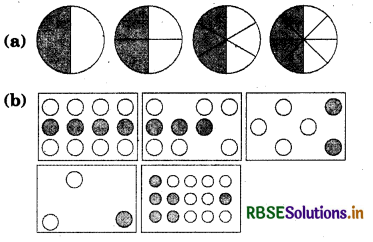
Answer:
(a) (i) Fraction of shaded part = \(\frac{1}{2}\)
(ii) Fraction of shaded part
= \(\frac{2}{4}=\frac{2 \div 2}{4 \div 2}=\frac{1}{2}\)
(iii) Fraction of shaded part
= \(\frac{3}{6}=\frac{3 \div 3}{6 \div 3}=\frac{1}{2}\)
(iv) Fraction of shaded part
= \(\frac{4}{8}=\frac{4 \div 4}{8 \div 4}=\frac{1}{2}\)
Hence, all these fractions are equivalent,
(b) (i) Fraction of shaded part
= \(\frac{4}{12}=\frac{4 \div 4}{12 \div 4}=\frac{1}{3}\)
(ii) Fraction of shaded part
= \(\frac{3}{9}=\frac{3 \div 3}{9 \div 3}=\frac{1}{3}\)
(iii) Fraction of shaded part
= \(\frac{2}{6}=\frac{2 \div 2}{6 \div 2}=\frac{1}{3}\)
(iv) Fraction of shaded part = \(\frac{1}{3}\)
(v) Fraction of shaded part
= \(\frac{6}{15}=\frac{6 \div 3}{15 \div 3}=\frac{2}{5}\)
Hence, all these fractions are not equivalent.

Question 2.
Write the fractions and pair up the equivalent fractions from each row:
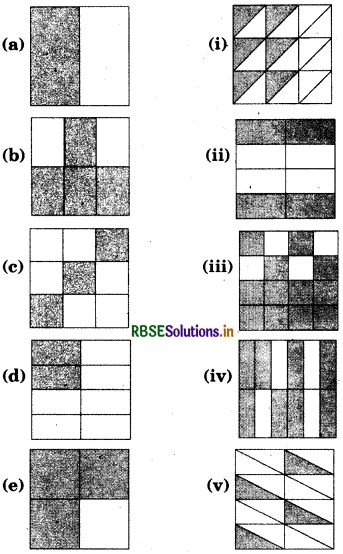
Answer:
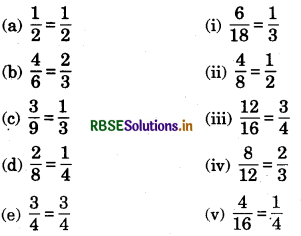
Now the equivalent fractions are :
(a) → (ii)
(b) → (iv)
(c) → (i)
(d) → (v)
(e) → (iii)
Question 3.
Replace in each of the following by the correct number:

Answer:
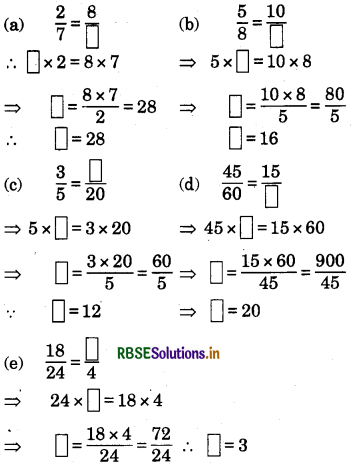

Question 4.
Find the equivalent fraction of \(\frac{3}{5}\) having:
(a) denominator 20
Answer:
Denominator 20
20 ÷ 5 = 4 so equivalent fraction of \(\frac{3}{5}\) is
\(\frac{3 \times 4}{5 \times 4}=\frac{12}{20}\), hence, required fraction = \(\frac{12}{20}\)
(b) numerator 9
Answer:
9 ÷ 3 = 3, so. equivalent fraction of \(\frac{3}{5}\) is
\(\frac{3 \times 4}{5 \times 4}=\frac{12}{20}\), hence, required fraction = \(\frac{9}{15}\)
(c) denominator 30
Answer:
30 ÷ 5 = 6, so equivalent fraction of \(\frac{3}{5}\) is
\(\frac{3 \times 4}{5 \times 4}=\frac{12}{20}\), hence required fraction = \(\frac{18}{30}\)
(d) numerator 27
Answer:
27 ÷ 3 = 9, so equivalent fraction of \(\frac{3}{5}\) is
\(\frac{3 \times 4}{5 \times 4}=\frac{12}{20}\), hence required fraction = \(\frac{27}{45}\)
Question 5.
Find the equivalent fraction of \(\frac{36}{48}\) with:
(a) numerator 9
Answer:
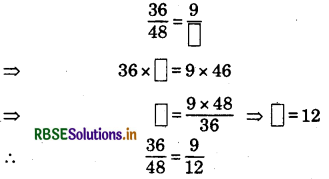
(b) denominator 4
Answer:
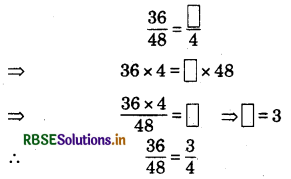
Question 6.
Check whether the given fractions are equivalent:
(a) \(\frac{5}{9}, \frac{30}{54}\)
Answer:
5 × 54 = 270 and 30 × 9 = 270
∴ 5 × 54 = 30 × 9
Hence, \(\frac{5}{9}\) and \(\frac{30}{54}\) are equivalent fractions.
(b) \(\frac{3}{10}, \frac{12}{50}\)
Answer:
3 × 50 = 150 and 12 × 10 = 120
∴ 3 × 50 ≠ 12 × 10
Hence, \(\frac{3}{10}\) and \(\frac{12}{15}\) are not equivalent fractions.
(c) \(\frac{7}{13}\), \(\frac{5}{11}\)
Answer:
7 × 11 = 77 and 3 × 5 = 15
∴ 7 × 11 ≠ 3 × 5
Hence, \(\frac{7}{13}\) and \(\frac{5}{11}\) are not equivalent fractions.

Question 7.
Reduce the following fractions into simplest form:
(a) \(\frac{48}{60}\)
Answer:
HCF of 48 and 60 = 12
∴ \(\frac{48}{60}=\frac{48 \div 12}{60 \div 12}=\frac{4}{5}\)
Hence, simplest form of \(\frac{48}{60}\) is \(\frac{4}{5}\)
(b) \(\frac{150}{60}\)
Answer:
HCF of 150 and 60 = 30
∴ \(\frac{150}{60}=\frac{150 \div 30}{60 \div 30}=\frac{5}{2}\)
Hence, simplest form of \(\frac{150}{60}\) is \(\frac{5}{2}\)
(c) \(\frac{84}{98}\)
HCF of 84 and 98 = 14
∴ \(\frac{84}{98}=\frac{84 \div 14}{98 \div 14}=\frac{6}{7}\)
Hence, simplest form of \(\frac{84}{98}\) is \(\frac{6}{7}\).
(d) \(\frac{12}{52}\)
∴ HCF of 12 and 52 = 4
∴ \(\frac{12}{52}=\frac{12 \div 4}{52 \div 4}=\frac{3}{13}\)
Hence, simplest form of \(\frac{12}{52}\) is \(\frac{3}{13}\).
(e) \(\frac{7}{28} \)
HCF of 7 and 28 is 4.
∴ \(\frac{7}{28}=\frac{7 \div 7}{28 \div 7}=\frac{1}{4}\)
Hence, simplest form of \(\frac{7}{28} \) is \(\frac{1}{4}\)
Question 8.
Ramesh had 20 pencils, Sheelu had 50 pencils and Jamaal had 80 pencils. After 4 months, Ramesh used up 10 pencils, Sheelu used up 25 pencils and Jamaal used up 40 pencils. What fraction did each use up? Check if each has used up an equal fraction of her/his pencils.
Answer:
For Ramesh :
Number of pencils Ramesh had = 20
Number of pencils used by him = 10
∴ Fraction of pencil used up = \(\frac{10}{20}=\frac{1}{2}\)
For Sheelu:
Number of pencils Sheelu had = 50
Number of pencils used by him = 25
∴ Fraction of pencil used up = \(\frac{25}{50}=\frac{1}{2}\)
For Jamaal:
Number of pencils Jamaal had = 80
Number of pencils used by him = 40
∴ Fraction of pencil used up = \(\frac{40}{80}=\frac{1}{2}\)
Yes, the fraction of pencils used by each of them is equal.

Question 9.
Match the equivalent fractions and write two more for each :
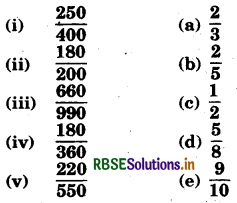
Answer:
(i) \(\frac{250}{400}\) Here, HCF of 250 and 400 = 50
∴ \(\frac{250}{400}=\frac{250 \div 50}{400 \div 50}=\frac{5}{8}\)
Hence, (i) → (d)
Two more equivalent fractions of \(\frac{5}{8}\) are :
\(\frac{5 \times 3}{8 \times 3}=\frac{15}{24}\) and \(\frac{5 \times 2}{8 \times 2}=\frac{10}{16}\)
(ii) \(\frac{180}{200}\) Here, HCF of 180 and 200 = 20
∴ \(\frac{180}{200}=\frac{180 \div 20}{200 \div 20}=\frac{9}{10}\) is its simplest form
Hence, (ii) → (e)
Two more equivalent fractions of \(\frac{9}{10}\) are :
∴ \(\frac{9 \times 2}{10 \times 2}=\frac{18}{20}\) and \(\frac{9 \times 3}{10 \times 3}=\frac{27}{30}\)
(iii) \(\frac{660}{990}\) Here, HCF of 660 and 990 = 330
∴ \(\frac{660}{990}=\frac{660 \div 330}{990 \div 330}=\frac{2}{3}\) is its simplest form
Hence, (iii) → (a)
Two more equivalent fractions of \(\frac{2}{3}\) are :
∴ \(\frac{2 \times 2}{3 \times 2}=\frac{4}{6}\) and \(\frac{2 \times 3}{3 \times 3}=\frac{6}{9}\)
(iv) \(\frac{180}{360}\) Here, HCF of 180 and 360 = 180
∴ \(\frac{180}{360}=\frac{180 \div 180}{360 \div 180}=\frac{1}{2}\) is its simplest foim
Hence, (iv) → (c).
Two more equivalent fractions of \(\frac{1}{2}\) are:
∴ \(\frac{1 \times 2}{2 \times 2}=\frac{2}{4} \) and \(\frac{1 \times 3}{2 \times 3}=\frac{3}{6}\)
(v) \(\frac{220}{550}\) Here, HCF of 220 and 550 = 110
∴ \(\frac{220}{550}=\frac{220 \div 110}{550 \div 110}=\frac{2}{5}\) its Slmplent from
Hence, (v) → (b)
Two more equivalent fractions of \(\frac{2}{5}\) are:
\(\frac{2 \times 2}{5 \times 2}=\frac{4}{10}\) and \(\frac{2 \times 3}{5 \times 3}=\frac{6}{15}\)

- RBSE Solutions for Class 6 Maths Chapter 2 Whole Numbers InText Questions
- RBSE Class 6 Maths Important Questions Chapter 1 अपनी संख्याओं की जानकारी
- RBSE Solutions for Class 6 Maths Chapter 7 भिन्न Intext Questions
- RBSE Solutions for Class 6 Maths Chapter 7 Fractions Ex 7.4
- RBSE Solutions for Class 6 Maths Chapter 1 Knowing our Numbers Ex 1.1
- RBSE Solutions for Class 6 Maths Chapter 1 Knowing our Numbers InText Questions
- RBSE Solutions for Class 6 Maths in Hindi Medium & English Medium
- RBSE Solutions for Class 6 Maths Chapter 7 Fractions InText Questions
- RBSE Solutions for Class 6 Maths Chapter 7 Fractions Ex 7.6
- RBSE Solutions for Class 6 Maths Chapter 7 Fractions Ex 7.5
- RBSE Solutions for Class 6 Maths Chapter 4 Basic Geometrical Ideas InText Questions